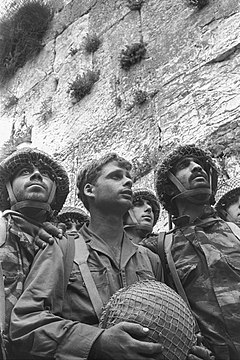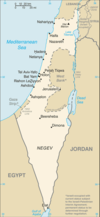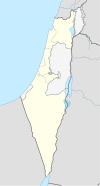Draft:Siege of Jerusalem (1967)
 | Draft article not currently submitted for review.
This is a draft Articles for creation (AfC) submission. It is not currently pending review. While there are no deadlines, abandoned drafts may be deleted after six months. To edit the draft click on the "Edit" tab at the top of the window. To be accepted, a draft should:
It is strongly discouraged to write about yourself, your business or employer. If you do so, you must declare it. Where to get help
How to improve a draft
You can also browse Wikipedia:Featured articles and Wikipedia:Good articles to find examples of Wikipedia's best writing on topics similar to your proposed article. Improving your odds of a speedy review To improve your odds of a faster review, tag your draft with relevant WikiProject tags using the button below. This will let reviewers know a new draft has been submitted in their area of interest. For instance, if you wrote about a female astronomer, you would want to add the Biography, Astronomy, and Women scientists tags. Editor resources
Last edited by WereSpielChequers (talk | contribs) 4 days ago. (Update) |
| Liberation of Jerusalem (1967) | |||||||
|---|---|---|---|---|---|---|---|
| Part of the Six-Day War | |||||||
 Paratroopers at the Western Wall Pictured by David Rubinger | |||||||
| |||||||
| Belligerents | |||||||
|
|
| ||||||
| Casualties and losses | |||||||
|
20 civilians killed 1,000 wounded |
| ||||||
| 582 killed in total | |||||||
| Part of a series on |
| Jerusalem |
|---|
 |
The Siege of Jerusalem (also known as the Battle of Jerusalem and the Reunification of Jerusalem ; (Hebrew:קְרָב יֵרֻושָלַים ; Arabic: معركة القدس) in Israel was once again compelled to fight for its existence. The third war forced upon Israel was also the shortest. Israel succeeded against all odds and prevailed over the armies of its three most powerful neighbors, which threatened to strangle it from the south, east and north. Jerusalem, Israel's capital, was reunited. For the first time in 19 years, the Old City was open to believers of all faiths and Jews could access their holiest sites. A war of self-defense
[3]was a military confrontation between the Israel Defense Forces and the Jordanian Army in the Six-Day War of June 1967. The decisive defeat of the Jordanians was critical to the eventual loss of the Jordanian Army to Israel. Leading Israeli forces was Major General Moshe Dayan , later a prominent politician and then became A Hero of Israel
Background
[edit]Jordan and an alliance of Arab states rejected the 1947 UN Partition Plan under which Jerusalem was to be a Corpus separatum, instead invading former Palestinian Mandate territory, and by the armistice in 1949 was in control of the Old City and East Jerusalem (excluding Mount Scopus). The Arab invading armies failed to take control over the rest of Israel, including West Jerusalem. The city was then divided along the 1949 Armistice Line. East Jerusalem was annexed to Jordan in 1950. The city remained divided until the Six-Day War in 1967.[4] As part of the Jordanian campaign[5] ,on June 5, 1967, the Jordanian Army began shelling Israel.When the Israeli cabinet convened to decide how to respond, Yigal Allon and Menahem Begin argued that this was an opportunity to take the Old City of Jerusalem, but Eshkol decided to defer any decision until Moshe Dayan and Yitzhak Rabin could be consulted.During the late afternoon of June 5, the Israelis launched an offensive to encircle Jerusalem, which lasted into the following day. On June 7, heavy fighting ensued. Dayan had ordered his troops not to enter the Old City; however, upon hearing that the UN was about to declare a ceasefire, he changed his mind, and without cabinet clearance, decided to capture it.[6]
Legacy
[edit]Jerusalem Day is an Israeli national holiday that commemorates the "reunification" of East Jerusalem (including the Old City) with West Jerusalem following the Six-Day War of 1967, which saw Israel occupy East Jerusalem and the West Bank, effectively annexing the former. It is celebrated annually on 28 Iyar on the Hebrew calendar, and is marked officially throughout Israel with state ceremonies and memorial services. A notable celebration that marks the holiday is a flag-flying parade known as the Dance of Flags. The Chief Rabbinate of Israel declared Jerusalem Day to be a minor religious holiday, as it marks the regaining for Jewish people of access to the Western Wall.[7]
International reactions
[edit]General Assembly Resolutions 2253[8] and 2254[9] of July 4 and 14, 1967, respectively, considered Israeli activity in Eastern Jerusalem illegal and asked Israel to cancel those activities and especially not to change the features of the city.[10] On 21 May 1968, United Nations Security Council Resolution 252 invalidated legal and administrative measures by Israel in violation of UNGA Resolutions 2253 and 2254 and required those measures be rescinded.[11]
UN criticism since 1967 includes UNSC resolutions in addition to 252, 267 (1969), 298 (1971) and resolution 476 (1980), regretting changes in the characteristics of Jerusalem, and resolution 478 (1980), where UN Member States were asked to withdraw their embassies from the city.[12] Resolution 478 also "condemned in "the strongest terms" the enactment of Israeli law proclaiming a change in status of Jerusalem." while Resolution 2334 of 2016 condemned all Israeli settlements in occupied territory including East Jerusalem.[13]
Impact
[edit]Under Jordanian rule no Jews were permitted to live in the city, which was governed as part of the Jordanian rule West Bank, and the Christian population plummeted, falling from 25,000 to 9,000.[14]
Freedom of worship by members of all faiths was restored immediately following reunification. The narrow, approximately 120 square metres (1,300 sq ft) pre-1948 alley along the wall used informally for Jewish prayer was enlarged to 2,400 square metres (26,000 sq ft), with the entire Western Wall Plaza covering 20,000 square metres (4.9 acres).[15] The Mugrabi Quarter was bulldozed in order to expand the plaza. In later years, synagogues demolished during the Jordanian rule, including the Hurva Synagogue were rebuilt.[16]
Under the direction of Nahman Avigad, the city's Jewish Quarter, which had largely lain in rubble, was carefully excavated before being rebuilt.[17][18] The complete rebuilding of the city's historic Jewish Quarter offered a virtually blank slate for city planners.[19][20] The reunification is celebrated by the annual Jerusalem Day, and Israeli national holiday. Special celebrations in 2017 to marked the Jubilee of the 1967 reunification.[21]
See also
[edit]- Six-Day war
- Jerusalem Day
- Arab-Israeli conflict
- Western Wall
- Al-Aqsa mosque
- Jordanian campaign (1967)
- Status of Jerusalem
References
[edit]- ^ https://main.knesset.gov.il/en/about/pages/jerusalem.aspx
- ^ אטלס כרטא לתולדות מדינת ישראל, עשור שני, עמ' 69.
- ^ The escalation to war began with renewed heavy shelling of Israeli agricultural villages from Syrian army positions overlooking them on the Golan Heights, Palestinian infiltrations into Israeli territory, and Egyptian President Nasser's outspoken threats to wipe Israel off the map and to throw the Jews into the sea. On 16 May 1967 Egyptian troops crossed the Suez Canal and entered the Sinai, moving quickly towards the border with Israel, despite the presence of United Nations Emergency Force (UNEF), whose purpose was to serve as a buffer between the sides. Further acts of aggression quickly followed, as the Syrian army placed itself on a war footing on the Golan Heights. On 19 May, UN Secretary General U Thant acceded to Egypt’s request to remove UNEF from Sinai, leaving Israel's southern border totally exposed to Egypt's army. On 22 May, in a move that constituted a casus belli [an act that justifies war], Egypt closed the Straits of Tiran to Israeli shipping, cutting off Israel’s only route to Asia and Iran, its main supplier of oil. Other leaders across the Arab world added their voices to the choir threatening to destroy Israel and by 4 June, the military alliance of Egypt, Syria, Jordan and Iraq was complete.
- ^ Britannica Upon the departure of the British occupying forces in May 1948 and the proclamation of the State of Israel, the armies of five Arab countries entered Palestine. In the ensuing conflict—the first of the Arab-Israeli wars—Israel expanded beyond the territory contemplated by the partition plan. The West Bank, as demarcated by the Jordanian-Israeli armistice of 1949, was broadly similar to (but smaller than) one of the zones designated as an Arab state by the United Nations (UN) partition plan for Palestine in 1947 (see United Nations Resolution 181). According to that plan, Jerusalem was to have been an international zone. However, the city was instead divided into Israeli (west) and Jordanian (east) sectors. The Arab state whose creation was envisioned by the 1947 UN partition plan never came into being, and the West Bank was formally annexed by Jordan on April 24, 1950, although this annexation was recognized only by Great Britain and Pakistan.
- ^ https://www.sixdaywar.org/jerusalem/1967-reunification-of-jerusalem/#:~:text=On%20June%207%2C%201967%2C%20IDF,commander%20of%20the%20brigade%2CLt. In the days before June 5, Jordan had deployed in the West Bank opposite Israel ten of its eleven brigades, totaling some 45,000 men. In the north were three infantry brigades: one near the Jordan river, opposite the Israeli town of Beit Shean, one around the city of Jenin, and one near the city of Tulkarem (where Israel is only about 10 miles wide). In the central sector were four brigades: an infantry brigade near Qalqilya, right on the Israeli border, another near Latrun, also on the border, and two around Jerusalem. In the south was an infantry brigade around Hebron, and in the rear, near the Damia bridge over the Jordan river and near Jericho, were two armored brigades, the main striking forces of the Jordanian army. The eleventh Jordanian brigade was deployed south of the Dead Sea, facing Israel’s Negev Desert and pointing towards the Egyptian forces in the Sinai. According to the joint Jordanian-Egyptian plans this brigade’s role was to fight into the Negev and link up with the advancing Egyptians, thereby cutting Israel in half. An Iraqi brigade, based on the other side of the Damia Bridge, with three more on the way, and two Egyptian commando battalions deployed near Latrun rounded out the forces arrayed against Israel on the Jordanian front. The western half of the West Bank — that is, the portion bordering on Israel — is mountainous and densely populated, especially the Old City of Jerusalem, and the large cities of Jenin, Nablus, Ramallah and Hebron. The terrain is nothing like the open spaces of the Sinai, so suited to tank warfare. In the West Bank the geography favored the defenders, offering innumerable ambush points and potential bottlenecks, which the Jordanians had supplemented by building many strategically located fortified positions, with trenches, bunkers, ammunition storerooms and gun emplacements. However, because Egypt was the strongest and most threatening of the Arab countries, Israel had to deploy the bulk of its forces in the south. Consequently, against the eleven Jordanian brigades and the Iraqi expeditionary force, the Israelis could muster only three infantry brigades and an armored brigade. Just after hostilities began between Israel and Egypt, the Egyptian commander Marshal Amer sent a message to Jordan’s King Hussein, reporting that 75 percent of Israel’s planes had been shot down or disabled, and urging Hussein to open a second front. As the King recounted in his book on the war
- ^ [[Britannica In Judaism: The situation today …of June 1967, Iyyar 28—Liberation of Jerusalem Day—is celebrated unofficially by many Israelis (see Arab-Israeli wars). Appropriate services are conducted on all the aforementioned holidays by most segments of Israel’s religious community. READ MORE In Jewish religious year: The situation today …June 1967 war, Iyyar 28—Liberation of Jerusalem Day—is celebrated unofficially by many Israelis. Appropriate services are conducted on all the aforementioned holidays by most segments of Israel’s religious community.
- ^ https://www.britannica.com/topic/Liberation-of-Jerusalem-Day
- ^ "A/RES/2253(ES-V) - E - A/RES/2253(ES-V) -Desktop". undocs.org.
- ^ "A/RES/2254(ES-V) - E - A/RES/2254(ES-V) -Desktop". undocs.org.
- ^ "UN resolutions on Jerusalem". www.aljazeera.com.
- ^ Database, E. C. F. "United Nations Security Council Resolution 252 (1968)". ecf.org.il.
- ^ Marshall J. Breger (2014). "Chapter 9:Jerusalem's Holy Sites in Israeli Law". In Silvio Ferrari, Dr Andrea Benzo (ed.). Between Cultural Diversity and Common Heritage: Legal and Religious Perspectives on the Sacred Places of the Mediterranean. Taylor & Francis. ISBN 9781472426031.
- ^ "UN resolutions on Jerusalem: Fifty years of futility". www.aljazeera.com.
- ^ Kollek, Teddy. "Jerusalem: Present and Future." Foreign Affairs 59, no. 5 (1981): 1041-049. doi:10.2307/20040902.
- ^ Ricca, Simone (Summer 2005). "Heritage, Nationalism and the Shifting Symbolism of the Wailing Wall; June 1967: Erasing The Past". Institute of Jerusalem (Palestine) Studies.
- ^ In the Holy Land, a Rebuilding for the Generations, The Wall Street Journal Online, March 10, 2010
- ^ Meyers, Eric M. (1992). "Nahman Avigad (1905-1992)". Proceedings of the American Academy for Jewish Research. 58: 1–5. ISSN 0065-6798.
- ^ Azaryahu, Maoz, and Arnon Golan. "Photography, Memory and Ethnic Cleansing: The Fate of the Jewish Quarter of Jerusalem, 1948—John Phillips' Pictorial Record." Israel Studies 17, no. 2 (2012): 62-76. doi:10.2979/israelstudies.17.2.62.
- ^ Efrat, Elisha, and Allen G. Noble. "Planning Jerusalem." Geographical Review 78, no. 4 (1988): 387-404. doi:10.2307/215090.
- ^ Kailani, Wasfi (2008). "Review of Reinventing Jerusalem: Israeli's Reconstruction of the Jewish Quarter after 1967". Middle Eastern Studies. 44 (4): 633–637. ISSN 0026-3206.
- ^ "PM announces extra NIS 850 million for Jerusalem". Times of Israel. JTA. 2 June 2016. Retrieved 9 February 2017.
Notes
[edit]- This is related to the Arab-Israeli conflict and the Six-Day War
- The battle caused the Israeli occupation of the West Bank


